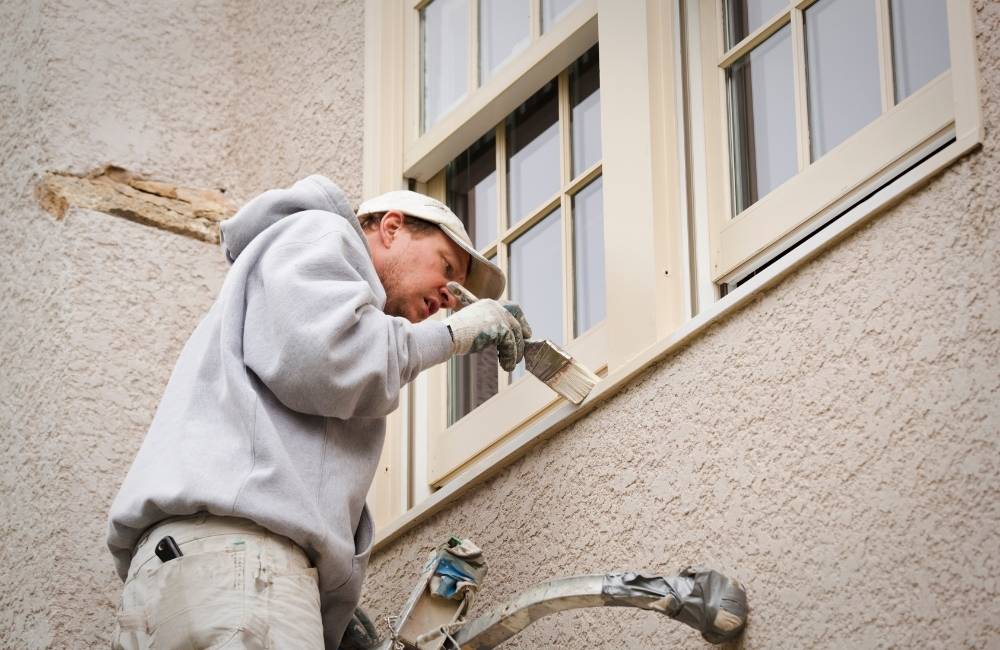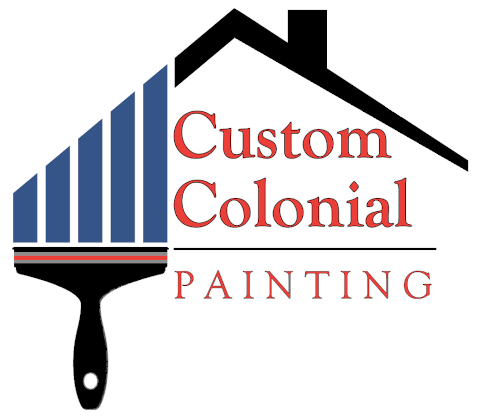Table of Contents
Key Takeaways
✔ During surface preparation for exterior painting, the surface is inspected for damage to ensure it’s ready for work.
✔ It is thoroughly cleaned to remove dirt, grime, and mildew for optimal paint adhesion.
✔ Cracks and holes are repaired to create a smooth, uniform foundation.
✔ Primer is applied to enhance adhesion and improve color consistency.
✔ Adjacent areas are masked and covered to protect them from paint splatters.
✔ A final inspection confirms the surface is fully prepared for a flawless paint job.
Surface preparation is the foundation of any successful exterior painting project, ensuring a flawless finish that lasts for years. According to a HomeLight survey of 1,000 real estate agents, painting your home’s exterior can add over $7,500 in resale value, yielding a remarkable 152% return on investment (ROI). Proper preparation not only enhances the appearance of your home but also protects it from the elements, ensuring durability and increased market value.
Here are the key steps involved in surface preparation to achieve a professional and long-lasting paint job.
6 Key Steps in Surface Preparation for Exterior Painting
1. Inspection and Assessment
When preparing a property for exterior painting, inspection, and assessment play a crucial role. This process ensures that the surface is ready to accept paint, minimizing the chances of future peeling, cracking, or other imperfections. Proper evaluation identifies existing problems that could compromise the paint’s adhesion and longevity.
Checking for Surface Damage
Assessing the condition of the surface helps determine its readiness for painting. This step involves a detailed examination of the exterior to spot any damage or flaws that require attention.
- Cracks: Identify hairline or larger cracks on walls, trim, or siding; these can allow moisture to seep in, potentially causing further structural damage.
- Peeling Paint: Look for areas where old paint is flaking or bubbling, as these need to be removed for the new paint to adhere effectively.
- Mold and Mildew: Detect dark spots or patches that indicate mold or mildew growth, often caused by trapped moisture. These areas require cleaning and treatment to prevent recurrence.
- Warping or Rot: Inspect wooden surfaces for warping, soft spots, or rot, which need replacement or repair before painting.
Identifying Areas Requiring Special Attention
Certain areas on the exterior may need extra care to ensure the paint job is durable and aesthetically pleasing.
- High-Traffic Zones: Surfaces near doors, windows, or walkways are prone to wear and tear and may require stronger primers or additional coats of paint.
- Shaded Areas: Spaces that do not receive direct sunlight often have higher moisture levels, increasing the likelihood of mold and mildew. These require thorough cleaning and treatment.
- Metal Components: Identify rusted or corroded metal parts, such as gutters or railings, which need to be sanded and treated with rust inhibitors before painting.
- Edges and Trim: Corners, edges, and trim often accumulate dirt and debris, demanding extra attention during cleaning and preparation.
2. Cleaning the Surface
Proper cleaning is a critical step in preparing for exterior painting. Removing dirt, grime, and mildew ensures the paint adheres correctly and lasts longer. This step requires attention to detail and the use of appropriate tools and techniques to create a smooth, clean surface ready for paint application.
Washing the Surface
Cleaning the exterior surface involves removing all accumulated contaminants that can prevent paint from bonding. This step is essential for achieving a professional finish.
- Pressure Washing: Pressure washing effectively eliminates dirt, dust, and other residues from walls. It is especially useful for textured surfaces like brick and stucco. Using the correct pressure settings prevents damage to delicate areas while thoroughly cleaning the surface.
- Scrubbing for Delicate Surfaces: In areas where pressure washing might cause damage, such as wood siding or trim, manual scrubbing with brushes and mild detergent is ideal. This approach ensures a gentle yet effective cleaning process.
- Mildew and Mold Removal: Using a bleach solution or a mildew-specific cleaner helps eliminate mold and mildew stains. This step is critical to avoid paint blistering or peeling caused by organic growth beneath the paint layer.
Ensuring the Surface is Dry
Drying the surface is equally important in the preparation phase. A wet surface can compromise the quality and longevity of the paint job.
- Allow Time for Natural Drying: After washing, it is essential to let the surface air dry completely. Warm, sunny days are ideal for this step, as they speed up the drying process.
- Use Drying Tools When Necessary: In cooler or more humid conditions, using tools such as fans or heaters can expedite drying. Ensuring every corner and crevice is dry prevents moisture-related issues during exterior painting.
3. Repairing Damaged Areas
Properly repairing damaged areas is a critical step in surface preparation for exterior painting. Addressing cracks, holes, and other imperfections ensures a smooth and even surface, which contributes to the longevity and professional appearance of the paint job.
Identifying and Filling Cracks and Holes
Before exterior painting can begin, it is essential to identify and fill any cracks or holes in the surface. Neglecting this step can lead to visible imperfections and compromise the durability of the paint.
- Inspect Cracks and Gaps: Look for visible cracks, gaps, or small holes that could disrupt the paint finish. Pay close attention to areas around windows, doors, and seams.
- Choose Appropriate Fillers: Use high-quality fillers such as exterior-grade caulk or putty to address gaps. Select materials that are compatible with the surface type, whether wood, stucco, or concrete.
- Apply Fillers Carefully: Fillers should be applied evenly, following the manufacturer’s instructions, to ensure that all imperfections are sealed properly.
Sanding Rough or Uneven Surfaces
Sanding is essential to create a smooth surface that enhances adhesion and ensures a polished final appearance for exterior painting.
- Identify Uneven Areas: Inspect the surface for bumps, ridges, or flaky remnants of old paint that can affect the smoothness.
- Use Appropriate Sanding Tools: Employ sanding blocks or power sanders for larger areas to achieve a consistent finish.
- Smooth Transitions: Focus on blending edges between patched areas and the original surface to avoid visible lines or textures.
Replacing Damaged Materials
In some cases, damaged areas may require more than just filling or sanding. Replacing compromised materials is vital for maintaining the structural integrity and aesthetic appeal of the exterior.
- Assess the Extent of Damage: Determine if the damage, such as rotting wood or crumbling stucco, warrants replacement instead of repair.
- Use Matching Materials: Replace damaged sections with materials that match the existing surface in texture, color, and durability. This ensures a cohesive look post-painting.
- Secure Installations: Ensure all new materials are securely installed and primed, providing a stable base for exterior painting.

4. Priming the Surface
Primer is a crucial step in exterior painting, ensuring paint adhesion, durability, and a smooth finish. It acts as a protective barrier against water, pollutants, and corrosion, often using inhibitors to prevent metal degradation, making it essential for long-lasting results.
Choosing the Right Primer
Selecting the appropriate primer for exterior painting is crucial for achieving the desired results. The choice depends on factors such as the type of paint, surface material, and environmental conditions.
- Paint Compatibility: Ensure the primer is designed to work with the specific type of exterior paint (e.g., oil-based or latex).
- Surface Material Suitability: Different primers are formulated for surfaces such as wood, metal, masonry, or stucco. Choosing the correct one enhances performance.
- Weather Resistance: Opt for a primer that offers weatherproofing properties, especially for outdoor applications exposed to varying climates.
Steps for Applying Primer
Applying primer correctly is essential to create a strong foundation for the exterior painting process. Follow these steps for the best results:
- Surface Preparation: Ensure the surface is clean, dry, and free from dust or grease. Remove loose paint and repair any damages.
- Priming Tools and Techniques: Use high-quality brushes, rollers, or sprayers suited to the surface. Apply primer evenly to avoid drips or pooling.
- Drying Time: Allow sufficient drying time as per the primer manufacturer’s recommendations to avoid issues with paint adhesion.
Common Mistakes to Avoid
While priming is straightforward, some errors can compromise the effectiveness of the process.
- Skipping Primer on Porous Surfaces: Porous materials like wood or masonry require a primer to seal the surface and ensure paint durability.
- Applying Primer Too Thinly: Insufficient primer application can result in patchy paint adhesion and an uneven finish.
- Ignoring Weather Conditions: Applying primer in extreme temperatures or high humidity can affect its drying and bonding properties.
5. Masking and Covering Adjacent Areas
Proper masking and covering of nearby surfaces are essential steps in ensuring a clean and professional finish during exterior painting. This process prevents accidental paint splatters and ensures the edges are sharp and precise, giving the final work a polished appearance.
Preparing to Mask and Cover Surfaces
Preparation is key to effective masking and covering. Ensuring the right tools and materials are on hand can streamline the process and improve results.
- Gathering Tools and Materials: Includes painter’s tape, plastic sheeting, drop cloths, and cutting tools for precision.
- Inspecting Areas for Coverage: Identifies surfaces needing protection, such as windows, doors, and landscaping elements.
Protecting Windows and Doors
Windows and doors are highly susceptible to accidental paint marks during exterior painting. Proper coverage ensures a neat appearance.
- Using Painter’s Tape: Ensures crisp lines along window frames and door edges, preventing paint seepage.
- Applying Plastic Sheeting: Covers glass surfaces completely to shield them from paint splatters.
Safeguarding Trim and Fixtures
Exterior painting projects often involve working near decorative trim and fixed hardware. These elements require careful protection to maintain their appearance.
- Wrapping Fixtures with Tape and Plastic: Ensures paint does not mar light fixtures, house numbers, or mailboxes.
- Masking Trim with Precision Tape: Creates a barrier that prevents overlap of paint onto adjacent trim.
Covering Landscaping and Surrounding Areas
Outdoor landscaping can be damaged by paint or cleaning solutions. Proper measures protect these elements while allowing access to painting areas.
- Laying Drop Cloths Over Plants: Protects flowers, shrubs, and grass near the painting zone from paint spills.
- Securing Outdoor Furniture: Moves or covers furniture and decorations to avoid accidental staining.
Ensuring Clean Edges and a Professional Finish
The effectiveness of masking and covering directly impacts the overall presentation of an exterior painting project.
- Double-Checking Coverage Before Painting: Ensures all areas needing protection are thoroughly covered.
- Pressing Tape Firmly Along Edges: Prevents paint bleeding, ensuring straight and clean lines.
- Removing Materials Carefully After Painting: Avoids smudging or tearing newly painted surfaces.
6. Final Inspection Before Painting
The final inspection is a critical phase in the preparation process for exterior painting, ensuring that the surface is in optimal condition to receive paint. This step guarantees that the investment in time and materials results in a durable, professional finish that stands the test of time and the elements.
Verifying Surface Readiness
The surface must meet stringent criteria to ensure paint adheres effectively and provides a smooth, even finish. The inspection involves a systematic check for cleanliness, smoothness, and dryness.
- Surface Cleanliness: Confirm that the surface is free of dust, dirt, mold, mildew, and other contaminants. Even minor debris can prevent the paint from bonding properly, leading to peeling or uneven coverage. This is especially important for areas exposed to heavy weather or pollution.
- Smoothness of Surface: Inspect the surface for rough patches, bumps, or leftover paint flakes. These irregularities can disrupt the uniform application of paint and detract from the finished appearance. Use fine-grit sandpaper to smooth out imperfections.
- Dryness: Ensure the surface is completely dry after cleaning or repairing. Residual moisture trapped in the surface can compromise paint adhesion, leading to blistering or bubbling over time.
Making Final Adjustments
Once the inspection identifies areas for improvement, targeted adjustments ensure the surface is fully optimized for exterior painting. No detail should be overlooked at this stage.
- Repair Missed Cracks or Holes: Small cracks or holes that were previously unnoticed should be filled with a high-quality exterior filler. Sand these areas to a seamless finish to avoid visible patches after painting.
- Re-Sand Uneven Spots: Any sections that feel rough to the touch or have visible inconsistencies should be sanded again. This step is crucial for achieving a flawless finish that highlights the paint’s quality.
- Touch-Up Primer: Reapply primer to areas where it may have worn thin or been removed during repairs. Primer is essential for ensuring consistent paint adhesion and color uniformity, particularly on patched or repaired sections.
Frequently Asked Questions
Can I paint over an old exterior paint, or should it be removed?
In many cases, you can paint over old exterior paint, provided it is in good condition. The surface must be clean, free of loose or peeling paint, and sanded to ensure proper adhesion. If the existing paint is extensively cracked or peeling, it’s necessary to scrape or strip it off before repainting. A primer is recommended when transitioning between drastically different colors or when painting over a glossy finish. For homes with lead-based paint, it’s essential to follow safety guidelines or hire professionals for proper removal.
What are the common mistakes to avoid during exterior painting?
Common mistakes include inadequate surface preparation, skipping primer, and using low-quality paint. Painting over dirty or damaged surfaces can result in poor adhesion and an uneven finish. Applying paint in unsuitable weather conditions, such as during high humidity or extreme temperatures, can also compromise the quality of the paint job. Neglecting to use drop cloths or tape can lead to unsightly splatters and uneven lines. Additionally, rushing through the process may result in uneven coverage or missed spots.
Should I hire a professional for exterior painting, or can I do it myself?
Whether to hire a professional or tackle exterior painting yourself largely depends on your skill level, available time, and the complexity of surface preparation. Proper surface prep is critical to a successful paint job and involves cleaning, repairing, sanding, and priming—all of which require specific tools and techniques. If done incorrectly, DIY surface prep can lead to poor paint adhesion, peeling, or an uneven finish, ultimately costing more to fix. While DIY may seem cost-effective, lack of expertise in prep work can make the process time-consuming and frustrating.
How can I ensure the exterior paint job lasts longer?
A long-lasting paint job depends on high-quality materials, proper preparation, and regular maintenance. Use premium paint and primer that are designed for exterior use and suited to your local climate. Thoroughly clean and repair the surface before painting to ensure good adhesion. Applying two coats of paint can enhance durability, especially in harsh weather conditions. After painting, inspect your home’s exterior annually for signs of wear and address small issues promptly to prevent larger problems.
How often should the exterior of a house be painted?
On average, the exterior of a house should be repainted every 5–10 years, depending on the material and climate conditions. Wood siding generally requires more frequent painting, usually every 3–7 years, while stucco can last up to 10 years before needing a new coat. Factors like intense sun exposure, heavy rainfall, or high humidity can shorten the lifespan of exterior paint. High-quality paint and proper preparation can extend the interval between paint jobs. It’s also a good idea to conduct regular inspections for peeling, cracking, or fading paint, as these are signs that your home may need a fresh coat sooner.
Trust Custom Colonial Painting for Flawless Exterior Painting in Westport, CT!
At Custom Colonial Painting, we specialize in meticulous surface preparation and expert exterior painting to ensure your home in Westport, CT looks stunning and withstands the elements. Our team takes pride in delivering a smooth, durable finish that enhances your property’s value and curb appeal. Whether it’s ensuring surfaces are clean and primed or applying premium paint with precision, we’re committed to providing exceptional service tailored to Westport, CT homeowners.
Contact Custom Colonial Painting today to experience the difference a professional touch can make for your home’s exterior in Westport, CT!



